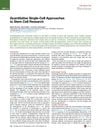Search
forLearn
5 / 8 resultslearn Osteopontin
signaling protein that, when suppressed, may grow hair by reducing inflammation and stem cell loss
learn Epidermal Growth Factor
learn Follistatin
glycoprotein that inhibits TGF-β and promotes hair growth by antagonizing activin
learn Thymosin Beta 4
Research
5 / 1000+ resultsresearch ScMC Learns Biological Variation Through the Alignment of Multiple Single-Cell Genomics Datasets
scMC effectively separates biological signals from technical noise in single-cell genomics data.

research Single-Cell Analysis Reveals Fibroblast Heterogeneity and Myeloid-Derived Adipocyte Progenitors in Murine Skin Wounds
The research found that different types of fibroblasts are involved in wound healing and that some blood cells can turn into fat cells during this process.

research Single-Cell Transcriptomics Defines Keratinocyte Differentiation in Avian Scutate Scales
The research identified two types of keratinocytes in chicken scales: one for hard scales and another for soft skin, with similarities to human skin differentiation.

research Quantitative Single-Cell Approaches to Stem Cell Research
New single-cell analysis techniques are improving our understanding of stem cells and could help in treating diseases.
research Single-Cell Sequencing Technology in Ruminant Livestock: Challenges and Opportunities
Single-cell sequencing can improve livestock health and productivity but faces challenges in precise cell analysis.
Community Join
5 / 1000+ resultscommunity 30-Min Dermatology Visit – Best Questions to Ask About Balding? ( 175$ )
The conversation discusses hair loss treatments, focusing on finasteride, minoxidil, and other options like PRP and ketoconazole. It highlights the importance of asking specific questions during a dermatology visit to determine the cause of hair loss and appropriate treatments.
community Polydopamine Synergizes with Quercetin Nanosystem to Reshape the Perifollicular Microenvironment for Accelerating Hair Regrowth in Androgenetic Alopecia.
A quercetin-encapsulated and polydopamine-integrated nanosystem (PDA@QLipo) shows promise for treating androgenetic alopecia by reshaping the perifollicular microenvironment, outperforming minoxidil in hair regeneration. The nanosystem promotes cell proliferation, hair follicle renewal, and recovery by scavenging reactive oxygen species and enhancing neovascularity.
community Scientists May Have Accidentally Found a Way to Reverse Hair Loss Without Drugs
2-deoxy-D-ribose is being explored as a hair loss treatment but is not proven effective in humans and may be costly and inconvenient. Minoxidil remains the most effective treatment.

community Compressed part of research of theory of androgenic/anabolitic balance. AGA h-responders analytic. Theory of physio-metabolitic method of anti AGA treatment
The treatment for androgenetic alopecia involves using finasteride and minoxidil with intense exercise and cold exposure to boost metabolism and reduce androgenic effects, potentially leading to hair regrowth. This approach may activate biological pathways for improved hair and overall health.
community 8 years of hair loss, turning 30 next month
The user has been dealing with hair loss for 10 years, worsened by psoriasis, and uses minoxidil and finasteride. They seek advice on managing psoriasis and hair loss, with suggestions to see a dermatologist, try different shampoos, and be patient.